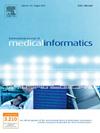使用RE-AIM框架对个性化数字护理路径工具的实施进行过程评估
IF 4.1
2区 医学
Q2 COMPUTER SCIENCE, INFORMATION SYSTEMS
International Journal of Medical Informatics
Pub Date : 2025-07-03
DOI:10.1016/j.ijmedinf.2025.106032
引用次数: 0
摘要
目的:本研究评估了个性化数字护理路径(PDCP)工具在三种不同患者群体(即疤痕诊所、唇裂护理和性别确认护理)中的实施情况。我们评估了患者用户的覆盖范围、患者感知到的信息提供(有效性)、医疗保健专业人员的采用、实践中的实施(包括感知满意度)和pdcp工具的可持续实施。材料,方法采用混合方法,按照Reach、Effectiveness、Adoption、Implementation and Maintenance (RE-AIM)框架对流程进行评价。数据收集包括实施前(n = 139)和实施后(n = 68)的患者问卷调查、工具用户统计、与患者和医疗保健专业人员的深度访谈(n = 16)和焦点小组(n = 4),并辅以研究人员的现场记录。结果使用该工具的大多数患者都具有数字素养,并且以前使用过其他医院应用程序。患者在使用pdcp -工具后感觉信息得到了充分的了解,但有些人表示几乎没有附加价值。对于医疗保健专业人员的采用,他们在开发过程中的参与和感知工具的附加价值是必不可少的。在实施方面,重要的是要有一个用户友好的工具,与现有系统集成并满足患者的信息需求。为了实现可持续的实施,需要医疗保健组织提供持续的财政和技术支持。结论pdcp -工具在提供适当的信息方面具有价值,特别是对数字和语言熟练,信息渴望的患者群体。该流程评估显示了在大型医疗保健组织中实施数字工具的许多有希望的元素。然而,在开发和实施过程中,实现和维持该工具的价值需要付出相当大的努力,因为它需要持续致力于使患者、医疗保健专业人员和组织始终关注该工具。未来的研究应该探索将这种工具集成到广泛使用的医院信息系统中的有效性,确保它成为医疗工作流程的一个组成部分,而不是一个独立的解决方案。本文章由计算机程序翻译,如有差异,请以英文原文为准。
Process evaluation of the implementation of a personalized digital care pathway tool using the RE-AIM framework
Objective
This study evaluated the implementation of a Personalized Digital Care Pathway (PDCP) tool in the context of three different patient groups (i.e. scar clinic, cleft care and gender-affirming care). We assessed the reach of patient users, information provision perceived by patients (effectiveness), adoption by healthcare professionals, implementation in practice including perceived satisfaction, and sustainable implementation of the PDCP-tool.
Materials & Methods
A process evaluation was conducted according to the Reach, Effectiveness, Adoption, Implementation, and Maintenance (RE-AIM) framework using mixed methods. Data collection included patient questionnaires administered before (n = 139) and after (n = 68) implementation, tool user statistics, and in-depth interviews (n = 16) and focus groups (n = 4) with patients and healthcare professionals, supplemented by researcher field notes.
Results
Most patients using the tool were digitally literate and had previously used other hospital applications. Patients felt well-informed after using the PDCP-tool, but some expressed little added value. For adoption by healthcare professionals, their involvement during development and perceived added value of the tool were essential. For implementation, it was important to have a user-friendly tool, that is integrated with existing systems and meets the information needs of patients. Ongoing financial and technical support by the healthcare organization is needed for sustainable implementation.
Conclusion
The PDCP-tool was found to be of value in providing appropriate information, particularly to digital and language proficient, information-hungry patient groups. This process evaluation showed many promising elements for implementation of a digital tool in a large healthcare organization. However, achieving and sustaining the value of the tool required considerable efforts during development and implementation, as it necessitated continuous commitment to keep it in the focus of patients, healthcare professionals and the organization. Future studies should explore the effectiveness of integrating such a tool into widely used hospital information systems, ensuring it becomes an integral part of the healthcare workflow, rather than a stand-alone solution.
求助全文
通过发布文献求助,成功后即可免费获取论文全文。
去求助
来源期刊

International Journal of Medical Informatics
医学-计算机:信息系统
CiteScore
8.90
自引率
4.10%
发文量
217
审稿时长
42 days
期刊介绍:
International Journal of Medical Informatics provides an international medium for dissemination of original results and interpretative reviews concerning the field of medical informatics. The Journal emphasizes the evaluation of systems in healthcare settings.
The scope of journal covers:
Information systems, including national or international registration systems, hospital information systems, departmental and/or physician''s office systems, document handling systems, electronic medical record systems, standardization, systems integration etc.;
Computer-aided medical decision support systems using heuristic, algorithmic and/or statistical methods as exemplified in decision theory, protocol development, artificial intelligence, etc.
Educational computer based programs pertaining to medical informatics or medicine in general;
Organizational, economic, social, clinical impact, ethical and cost-benefit aspects of IT applications in health care.
 求助内容:
求助内容: 应助结果提醒方式:
应助结果提醒方式:


